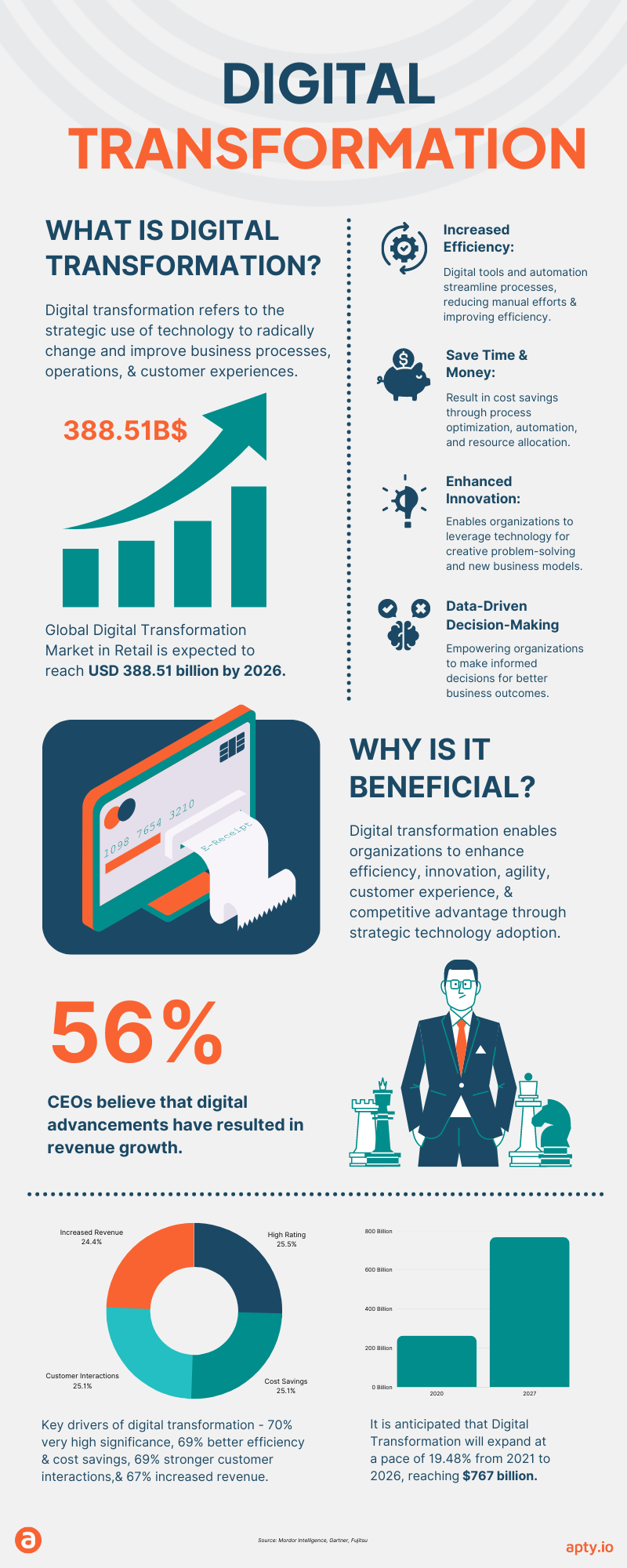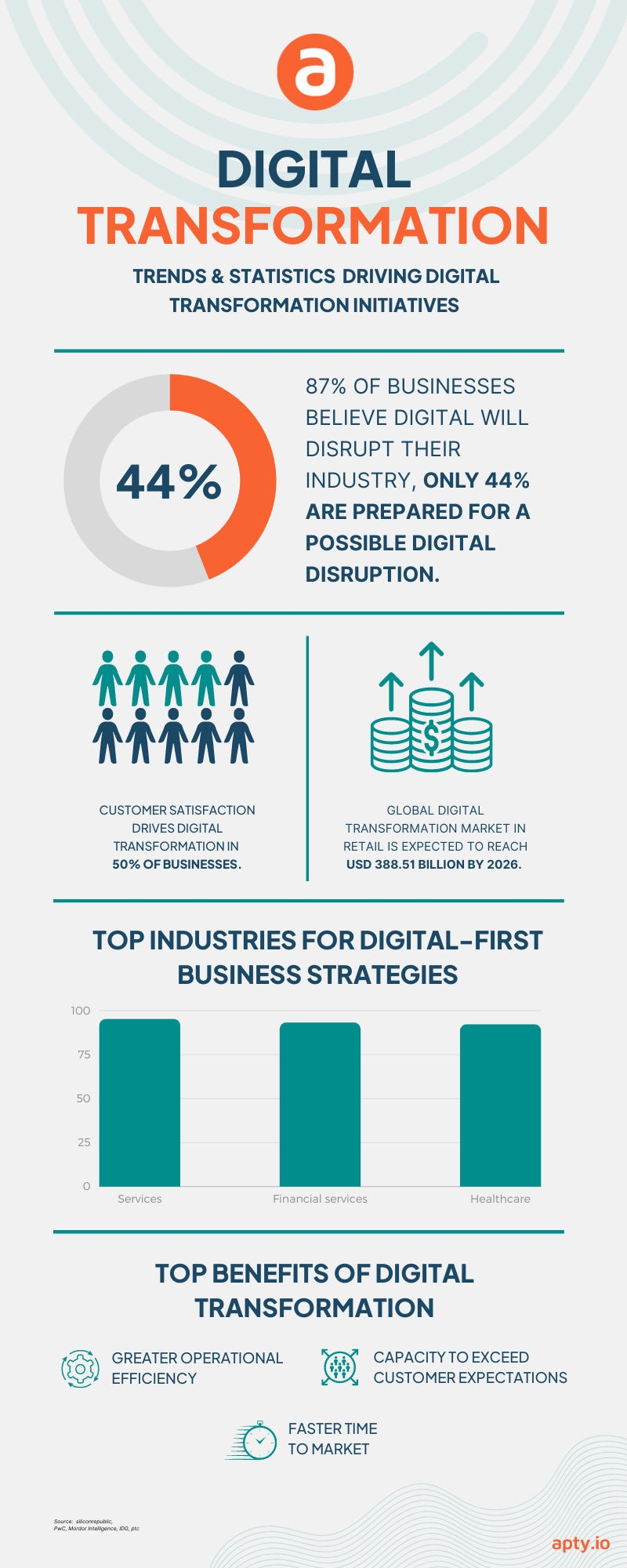The Covid-19 pandemic has taught us valuable lessons, including the importance of digital transformation, digital democratization, secure cloud-based oversight, employee-led virtual training, and department uncoupling and autonomy. As companies strive to remain competitive in the modern business landscape, digital transformation is a crucial aspect that cannot be ignored. In 2024, the latest Digital transformation statistics will continue to shape the industry, and it is essential for CIOs to understand these trends and drive digital transformation initiatives within their organizations.
One of the key areas where digital transformation can have a significant impact is the Enterprise Employee Experience. Businesses must prioritize employee experience, which can positively impact workforce productivity and overall business success. By exploring the latest statistics around digital transformation and Enterprise Employee Experience, companies can gain valuable insights into optimizing their workforce and staying ahead of the curve.
Post-pandemic, there is an undeniable desire for remote or hybrid workplace options, and employees have high expectations for digital initiatives. However, only a few digitally mature enterprises have successfully implemented and scaled their digital transformation initiatives while maintaining a positive employee experience. Businesses that prioritize digital transformation can enhance their financial performance and other critical criteria that determine organizational success.
Stay updated on the latest Digital transformation statistics 2024 and prioritize digital transformation initiatives to remain competitive, drive innovation, and optimize your workforce’s productivity and experience.

Here are a few digital transformation statistics laying the foundation for the shift in CIO & CEO strategies in coming years:
Digital Transformation Timeline & Scope Statistics:
- 89% of all businesses have already implemented or plan to implement a digital-first company strategy.
- 70% of businesses have a digital transformation plan in place or are developing one.
- 34% of organizations have already undertaken a digital transformation, according to Smart Insights.
- 55% of start-ups, compared to 38% of typical businesses, have implemented a digital business strategy.
- 85% of business decision-makers believe they have two years to make substantial progress in the area of digital transformation.
- 39% of executives believe that their organizations will benefit the most from digital initiatives in 3-5 years.
- 21% of businesses believe they have achieved digital transformation.
- Most transformation efforts continue to focus on modernizing customer touchpoints (54%) and enabling infrastructure (45%).
- 60% of businesses that have gone through a digital transformation have developed new business models.
- The majority of digital transformations are motivated by prospects for development, followed by greater competitive pressure and new regulatory norms.
- 59% of organisations that have not begun a digital transformation worry they might be too late.
- According to Fujitsu, the key drivers of digital transformation in retail include greater competitiveness, with 70% rating high or very high significance, 69% better efficiency and cost savings, 69% stronger customer interactions, and 67% increased revenue.
- According to Fujitsu, 71% of respondents, i.e., more than two-thirds, believe that digital transformation is a vital component of retail technology.
Digital Transformation Budgets & ROI Statistics 2024:
- According to a Gartner study, 56% of CEOs believe that digital advancements have resulted in revenue growth.
- ICC study states that, digital transformations will account for 40% of all technology investment.
- To speed up efforts related to digital transformation, such as analytics platforms, security operations, and analytics platforms, 55% of CIOs want to hire more full-time IT employees.
- Companies will spend a total of more than $2 trillion on digital transformation.
- 41% of businesses are investing in digital transformation without conducting extensive customer research.
- Digital transformation is still often perceived as a cost centre (28%), and data to prove ROI is hard to come by (29%).
- 55% of businesses without a digital transformation feel they have less than a year before losing market share.
- By investing in customer experience, businesses with annual revenue of $1 billion can generate an extra $700 million over the course of three years.
- Digital improvements, according to 56% of CEOs, have boosted revenue.
- The Global Digital Transformation Market in Retail is expected to reach USD 388.51 billion by 2026.
- According to Gartner, 63% of retailers plan to increase their spending on business intelligence/data analytics, while 35% plan to increase their spending on artificial intelligence.
- McKinsey suggest, virtualisation could be possible for up to $250 billions of current US healthcare spending (20% of total spending).
- According to BusinessWire, there will be a total revenue opportunity of more than $34 billion in the healthcare AI sector by 2025.
- According to Statista, the worldwide market for digital health is anticipated to reach more than 500 billion dollars by 2025.
- According to Grand View Research, the worldwide market for virtual and augmented reality in healthcare is predicted to reach $5.1 billion by 2025.
- 360 Market Updates claims, with a CAGR of 23% from 2018 to 2023, the market for wearable medical devices is anticipated to reach $27.2 billion by 2023.
- According to MarketsandMarkets, the market for healthcare chatbots will grow from $122 million in 2018 to $314.3 million by 2023.
- Digital transformation in the industrial sector was worth $263 billion in 2020. Mordor Intelligence anticipates that it will expand at a pace of 19.48% from 2021 to 2026, reaching $767 billion.
- Global investment on digital transformation services and technology is expected to reach $2.3 trillion by 2023.
The Effect & Success of Digital Transformation on Enterprises – Statistics 2024:
- Implementing digital technology accelerates organizational progress by 22%.
- Only around 30% of businesses successfully manage a digital transformation.
- Businesses that prioritise cultural transformation are 5X more likely to achieve breakthrough performance than those that do not.
- The top benefits of digital transformation, according to executives, are greater operational efficiency (40%), faster time to market (36%), and the capacity to exceed customer expectations (35%).
- A completely integrated digital-physical approach is used by 39% of outperforming businesses.
- Digital-first companies are 64% more likely to achieve their business goals than their peers.
- A study from Fujitsu states that Only one in ten merchants, or 9.5%, claim to be extremely early adopters, while another quarter, or 27%, claim to be relatively early adopters, and 37% claim they do not fit into either group, i.e., they are neither late adopters nor early adopters.
- IDG States that, the top three industries for digital-first business strategies are the service sector (95%), the financial services sector (93%), and the healthcare sector (92%).
- A Forbes study states that, 75% of banks and credit unions have started a digital transformation programme
- According to Forbes, over half of the banks that started their strategy in 2020—more specifically, 46%—have completed at least half of it.
- ITIC reports that 86% of industrial companies estimate the cost of a single hour of downtime in their hardware, software, networks, or other gear to be at least $300,000.
- The majority of firms are turning to digital solutions to address environmental sustainability.
- Virtual customer assistants are expected to be used in 25% of all customer support activities.
- An online knowledge base, an app, or a chatbot are examples of the digital self-service options that 60% of American consumers say they prefer for customer assistance.
- 42% of office workers report a good Digital Employee Experience, and of knowledge workers 44%.
- 80 to 93% of employees don’t think that increased technology has improved business performance.
Digital Transformation Stakeholder Statistics 2024:
- CIOs are most frequently stated to own or sponsor digital transformation initiatives (28%), with CEOs increasingly taking on leadership roles (23%).
- The position of Chief Innovation Officer as an executive sponsor of digital transformation is growing, with a 64% increase since last year.
- 35% of leaders and managers were reported to have a good or very good Digital Employee Experience.

Digital Transformation Trends & Challenges Statistics 2024:
- Cultural factors are also a significant barrier to growth, with entrenched viewpoints, reluctance to change (26%), and legal and compliance concerns (26%).
- High-profile data breach incidents in the headlines daily, as well as new legal criteria such as GDPR, are creating incentive for firms to restructure (38%).
- Market pressures are the primary drivers of digital transformation, including growth opportunities (51%) and greater competitive pressure (41%).
- The top industries for digital-first business strategies are services (95%), financial services (93%) and healthcare (92%).
- Businesses that are more digitally advanced than their counterparts are 23% more lucrative.
- The typical interaction worker spends approximately 20% of their time trying to find internal information or locating a co-worker who can assist them.
Role of Technology in Digital Transformation Statistics 2024:
- Nearly 77% of businesses claim they have an average or above average relationship with technology.
- 45% of CEOs believe their organisation lacks the necessary technologies to accomplish a digital transformation.
- By 2025, 90% of new enterprise applications’ operations and products will be powered by AI.
- According to McKinsey, 25% of the insurance business will be automated in 2025 as a result of AI and machine learning techniques since the insurance sector is full of bottlenecks and manual processes.
- Forrester researchers predict that by 2030, automation will have eliminated 29% of employment while creating 13%.
- According to Statista data, 58% of business and HR leaders worldwide use AI to assist workers in their organisations, with the main use of AI in this context being to improve consistency and quality. A further 26% stated that AI is used to assist workers by improving productivity, with the remaining 16% using it to improve insights.
- Intelligent systems will drive 70% of customer interactions by 2022.
- 63% of customers are content to get assistance from a bot as long as they can speak with a human agent if necessary.
- 65% of consumers utilize online product research before visiting a physical store.
- 61% of supervising employers say they spend more time than they’d like getting technology to operate.
- 80% of Americans experience some type of frustration with technology every day.
Customer Experience & Consumer Impact Statistics – (Marketing, Consumers):
- Customer experience will be involved in more than 40% of all data analytics projects.
- 52% of marketers around the world say driving growth through digital transformation is their top strategic focus.
- 55% of marketers prioritise better audience segmentation and targeting.
- 30% of US consumers believe customer service chatbots are very successful at addressing difficulties, while 12% say they aren’t at all effective.
- Almost half of all businesses indicate that enhancing customer experience and satisfaction were the driving forces behind their decision to embark on a digital transformation.
- Almost half of all businesses indicate that enhancing customer experience and satisfaction were the driving forces behind their decision to embark on a digital transformation.
- Live chat services satisfy 92% of consumers, making it the support channel with the greatest customer satisfaction.
Impact of Digital Transformation on Businesses & Workforce – Statistics:
- According to 27% of business, digital transformation is a question of survival.
- Although 87% of businesses believe digital will disrupt their industry, just 44% are prepared for a possible digital disruption.
- According to 71% of digitally mature organisations, their use of data will attract fresh talent, compared to 10% of early-stage digital organisations.
- Digital skills are vital in today’s workplace. According to the World Economic Forum, 54% of all jobs will need significant retraining.
- PwC Study claims, 55% of businesses that are most concerned about digital skills believe that a shortage of crucial skills is impeding innovation.
- Jobs such as insurance underwriting, warehousing and manufacturing, and customer service are likely to be automated within the next 5 to 10 years.
- Only 16% of employees believe their company’s digital transformation has increased productivity and is long-term sustainable.
- Employees at firms with less than 100 employees are nearly 3X more likely than employees in companies with more than 50,000 employees to consider their digital transformation was a success.
- According to a Gallup study on company culture, highly engaged employees reduce absenteeism by 41% and enhance productivity by 17%.
- According to the Gallup study, organisations with highly engaged employees are 21% more profitable.
- IDC study on employee experience, 85% of respondents felt that an improved employee experience would be beneficial.
- According to a Gallup survey on enhancing productivity, disengaged employees pay their organisation the equivalent of 18% of their annual salary.
- As per a study of engaged employees, they are 23X more likely to promote their company as a wonderful place to work.
- Based on a Gallup study on employee health concerns, actively engaged employees have 1.25 unhealthy days per month, whereas actively disengaged employees have 2.17 unhealthy days per month.
- US L&D survey on workplace learning, organisations with highly engaged employees were 94% more likely to offer training to employees.
- Job seekers claim that 46% of job seekers agree that employee experience is very important for choosing a job.
- According to business culture research, engaged organisations had 59% lower turnover.
- 15% turned down an offer because of bad company culture, according to Job seekers .
- 67% of Gen Z respondents claimed that 4-day working week works as a decision-making factor when choosing an employer.
- In the US, 55% of employees said they wanted to continue working remotely for at least three days of the week in the future, claims PWC.
- Companies with strong employee engagement are 21% more lucrative.
- Companies can raise the productivity of knowledge workers by 20 to 25% by using social technologies.
- Only 17% of frontline workers report a good or very good Digital Employee Experience.
Post-COVID Impact on Digital Transformation:
- During the pandemic, consumers used digital tools for health support at a rate that increased by 15%. 37% of customers, according to McKinsey, are very likely to adopt telehealth in the future.
- According to McKinsey, the usage of telehealth rose from 11% to 76% as a result of the pandemic.
- Because of the COVID-19 pandemic’s consequences, global digital transformation expenditure in logistics is estimated to reach $84.6 billion by 2027.












